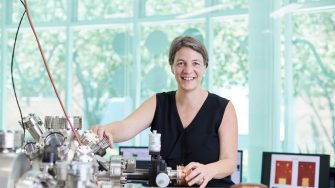
ARC Centre of Excellence in Quantum Computation and Communication Technology
Project ID: 155
Supervisor(s): Michelle Yvonne Simmons
Professor Michelle Simmons is the Director of the ARC Centre of Excellence in Quantum Computation and Communication Technology. There are two projects available to honours students: Demonstrating a 2-Qubit Gate in Silicon; and Demonstrating a Logical Qubit in Silicon.
Demonstrating a 2-Qubit Gate in Silicon
In this project you will work within the Centre of Excellence for Quantum Computation and Communication Technology and the new quantum computing company, Silicon Quantum Computing Pty. Ltd. to design and demonstrate a two qubit gate architecture in silicon.
There is a lot of interest in quantum computation as a promising alternative to conventional silicon electronics for massively parallel computing. Whilst quantum logic operations have been demonstrated in several systems including superconducting circuits, photonic qubits, quantum dot qubits and electromagnetic ion traps, there is an international race to demonstrate a two qubit gate in single atom qubits in silicon. In particular, donor-spin qubits in silicon represent one of the most promising qubit types since they have extremely long coherence times with very high fidelities.
Recently the team at UNSW has demonstrated high fidelity single qubit initialization [1] and read-out [2] as well as coherent manipulations of donor-bound spins in silicon [3]. This project will takes these results to the next step to demonstrate a 2-qubit gate, one of the critical components of a Si:P donor-based quantum computer. In particular this project aims to demonstrate two-spin correlations by the means of single-shot spin read-out of pairs of donor-bound electron spins which are mutually tunnel-coupled as well as tunnel-coupled to single-electron transistors (SETs). Two-spin manipulations will be driven within the two-spin basis of the tunnel-coupled spin-pair. Read-out of the two-spin system will thereby be achieved through either spin-to-charge conversion via Pauli spin blockade or via spin selective tunneling to an SET island within the same device architecture.
This work will comprise of working in a dedicated team to: (i) Design the device architecture for high fidelity spin initialization, control and single shot spin read-out, (ii) Fabricate devices in a full silicon CMOS cleanroom with the manipulation of individual donors performed using scanning probe lithography and (iii) Measure devices at cryogenic temperatures for high spin coherence, using the nanofabricated gates and microwave magnetic fields for spin control and readout. The results achieved will build on the recently demonstrated coupled donor qubits [4] and represent the absolute latest benchmark in silicon based quantum computing. Whilst ambitious the goal of achieving a 2-qubit gate will maintain international leadership in this field and provide a critical component of a long term scalable quantum computing architecture [5].
[1] T. F. Watson et al., Physical Review Letters 115, 166806 (2015).
[2] T. F. Watson et al., Science Advances 3, e1602811 (2017).
[3] M.A. Broome et al, paper under review (2017).
[4] B. Weber et al., Nature Nanotechnology 9, 430 (2014).
[5] C. Hill et al., Science Advances 1, e1500707 (2015).
Demonstrating a Logical Qubit in Silicon
In this project you will work within the Centre of Excellence for Quantum Computation and Communication Technology and the new quantum computing company, Silicon Quantum Computing Pty. Ltd. to design and demonstrate a logical qubit in silicon.
Over the past decade the precision qubit team at UNSW has demonstrated high fidelity single shot spin initialisation and read-out [1], being able to read out two separate spins separated by ~20nm [2] and demonstrate spin correlations between adjacent spin qubits [3]. One of the challenges going forwards is to demonstrate error detection and correction in donor qubits in silicon towards the long term goal of demonstrating a full-scale quantum computing architecture [4].
The project will involve (i) the design of error detection and correction device architectures along with (ii) the design of the circuit diagrams for their operation. It will also require (iii) designing and (iv) implementing RF circuits for high speed single shot spin read-out. The student will work in a dedicated team to fabricating and measuring 3 and 4 qubit architectures for error detection and correction. They will experience the fabrication of devices in a full silicon CMOS cleanroom with the manipulation of individual donors performed using scanning probe lithography. They will also be directly involved in low noise, high frequency measurements of the qubit architectures at cryogenic temperatures.
[1] T. F. Watson et al., Physical Review Letters 115, 166806 (2015).
[2] T. F. Watson et al., Science Advances 3, e1602811 (2017).
[3] M.A. Broome et al, paper under review (2017).
[4] C. Hill et al., Science Advances 1, e1500707 (2015).
